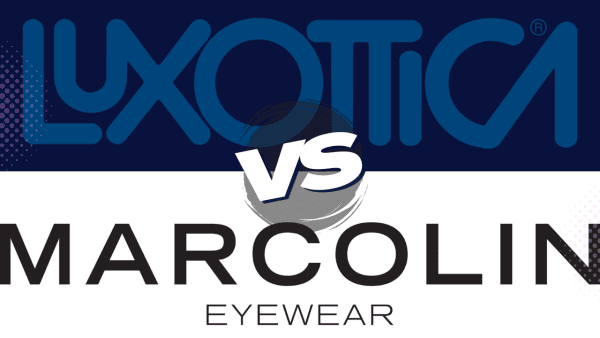
Marcolin and Luxottica are the two most prominent names in the world of luxury eyewear. Each of these brands has become recognized as among the best in the field and has a devoted clientele, a varied product portfolio, and a long history. However, there are significant disparities between their methodologies, ideologies, and commercial strategies. We’ll examine the history, salient distinctions, and ongoing influence on the eyeglass market as we examine the rivalry between Marcolin and Luxottica in this blog post.
Marcolin vs Luxottica
Marcolin and Luxottica are both Italian brands, recognized internationally for their exceptional design and craftsmanship. Decades have passed since these two eyewear industry titans began competing for dominance, each bringing its own set of distinctive qualities to the table.
Since its inception by Leonardo Del Vecchio in 1961, Luxottica has positioned itself as the undisputed market leader in eyewear. Luxottica, whose portfolio includes renowned labels including Ray-Ban, Oakley, and Persol, holds a substantial portion of the worldwide market. By virtue of its vertically integrated business model, which incorporates design, manufacturing, and distribution, the company possesses exceptional authority over the complete supply chain.
On the other hand, Marcolin, established by Giovanni Marcolin in 1961, has successfully established a distinct and specialized position within the industry. Marcolin, although not as dominant as Luxottica, has established collaborations with esteemed fashion houses including Ermenegildo Zegna, Tom Ford, and Balenciaga. By establishing these partnerships, Marcolin has reinforced its standing as an authority on opulence and ingenuity, providing discerning clientele with an extensive selection of premium eyewear alternatives.
Innovation and Design
Both Marcolin and Luxottica prioritize design and innovation, continuously expanding the limits of what eyewear can possibly be. Luxottica has been at the forefront of technological advancements, including customizable frames, polarized lenses, and lightweight materials, due to its state-of-the-art research and development facilities. This dedication to innovation has contributed to the company’s industry leadership by stimulating consumer demand and establishing trends.
Marcolin similarly takes great pride in its pioneering methodology towards design. By engaging in close collaborations with fashion designers and trendsetters, Marcolin is able to produce eyewear that surpasses its functional purpose and embodies an aura of sophistication and elegance. Marcolin consistently challenges conventional norms by exploring avant-garde aesthetics, unconventional materials, and daring silhouettes, thereby appealing to fashion-conscious individuals who desire to express themselves.
Market Presence and Global Footprint
Marcolin and Luxottica both possess extensive distribution networks that extend across continents, conferring a formidable global presence. Due to its strategic alliances and vast retail footprint, Luxottica maintains an omnipresent presence in the world’s majority of markets. By means of department store concessions and standalone boutiques, Luxottica’s brands enjoy widespread consumer accessibility on an international scale, thereby guaranteeing optimal brand exposure and visibility.
Marcolin, in a similar vein, has effectively broadened its scope by capitalizing on its collaborations with renowned fashion houses in order to enter untapped markets and demographic segments. By utilizing a variety of distribution channels (including online platforms, premium department stores, and exclusive boutiques), Marcolin has successfully developed a devoted clientele consisting of astute connoisseurs who value the brand’s dedication to excellence and skills.
What the Future Holds
The ongoing evolution of the eyewear industry is reflected in the fierce competition that Marcolin and Luxottica continue to engage in. While Luxottica’s supremacy may appear insurmountable, Marcolin has a distinct advantage in the ever-evolving fashion and luxury industry due to its agile approach and emphasis on collaboration. Niche-style eyewear or designer brands such as Oakley and Ray-Ban are not the only options available to consumers; the rivalry between Marcolin and Luxottica guarantees an inexhaustible selection.
Frequently Asked Questions About Marcolin vs Luxottica
1. What is the difference between Marcolin and Luxottica?
Marcolin and Luxottica are both major players in the eyewear industry, but they differ in their business models and strategies. Luxottica is known for its vertically integrated approach, controlling everything from design and manufacturing to distribution and retail through its extensive network of stores, including Sunglass Hut and LensCrafters. On the other hand, Marcolin primarily focuses on manufacturing premium eyewear for a wide range of luxury brands and fashion houses, forging partnerships to create bespoke collections tailored to each brand’s identity.
2. Which brands are owned by Luxottica and Marcolin?
Luxottica boasts an impressive portfolio of brands, including Ray-Ban, Oakley, Persol, Vogue Eyewear, and Oliver Peoples, among others. Marcolin, on the other hand, partners with luxury fashion houses and lifestyle brands such as Tom Ford, Balenciaga, Ermenegildo Zegna, Moncler, and Guess, producing eyewear collections under these labels.
3. How do Luxottica and Marcolin impact the eyewear market?
Luxottica’s vertical integration gives it significant control over the eyewear market, allowing the company to influence pricing, distribution channels, and consumer trends. Its extensive retail network ensures broad exposure for its brands and products. Marcolin’s approach, centered around brand partnerships and craftsmanship, contributes to the diversification of the market by offering unique eyewear collections tailored to different brands’ identities and customer bases.
4. Which company offers better quality eyewear?
Both Luxottica and Marcolin are known for their commitment to quality and craftsmanship. Luxottica’s vertically integrated supply chain enables rigorous quality control across all stages of production, ensuring consistency and reliability. Marcolin, on the other hand, leverages its expertise in design and manufacturing to create bespoke eyewear collections that reflect the distinct aesthetics and values of its partner brands.
5. How do Luxottica and Marcolin influence pricing in the eyewear industry?
Luxottica’s dominant market position and vertical integration give it significant pricing power, allowing the company to set premium prices for its brands and products. Additionally, its extensive retail network enables Luxottica to control pricing and promotions across various distribution channels. Marcolin’s pricing strategy varies depending on the brand it partners with, but its focus on craftsmanship and luxury positioning often results in higher price points for its eyewear collections.
6. What are the recent developments or mergers involving Luxottica and Marcolin?
In recent years, Luxottica merged with Essilor, a leading manufacturer of ophthalmic lenses, to form EssilorLuxottica, creating a global eyewear powerhouse with unparalleled expertise and market dominance. Meanwhile, Marcolin has continued to expand its portfolio through strategic partnerships and acquisitions, strengthening its position as a key player in the luxury eyewear market.
7. How do consumers benefit from the competition between Luxottica and Marcolin?
The competition between Luxottica and Marcolin ensures a diverse range of high-quality eyewear options for consumers, catering to different tastes, styles, and budgets. Whether you prefer iconic brands like Ray-Ban and Oakley or seek the exclusivity of designer eyewear collections, the rivalry between Luxottica and Marcolin ensures that there is something for everyone in the dynamic and ever-evolving world of eyewear.
Conclusion
Whether you favor the exclusive collaborations of Marcolin or the iconic brands of Luxottica, one thing is certain: the struggle between eyewear titans is far from over. The potential developments and influences of these industry leaders leave the future of fashion and eyewear uncertain. Therefore, regardless of whether you are donning a pair of Tom Ford frames or your preferred pair of Ray-Bans, bear in mind that each renowned design originates from a narrative of competition, ingenuity, and exceptional artistry.

Leave a Reply